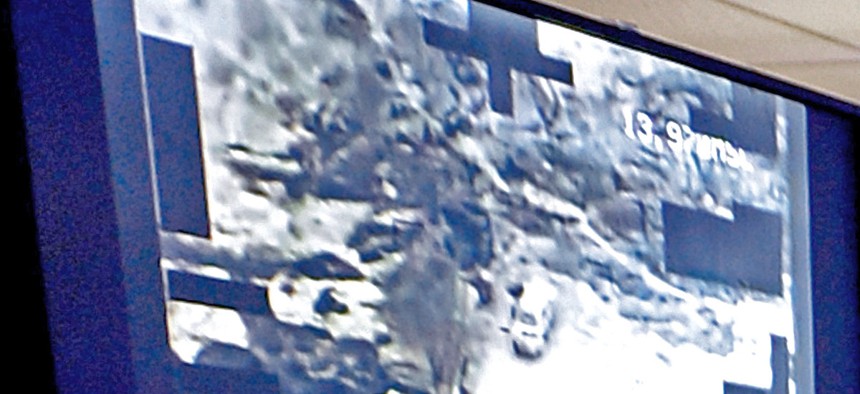
The Distributed Common Ground System is the Air Force’s primary intelligence, surveillance and reconnaissance collection, processing, exploitation, analysis and dissemination system. U.S. Air Force
A Look Inside a Secret US Air Force Intelligence Center
With no U.S. boots on the ground in Syria and not many in Iraq, it’s up to young intelligence analysts here to search for Islamic State militants. By Marcus Weisgerber
LANGLEY AIR FORCE BASE, Va. – While there might not be any American combat boots on the ground in Syria, dozens of manned and unmanned aircraft dot the skies above gathering video and other types of intelligence about the movement of Islamic State militants. The images collected by those aircraft are streamed by satellites in near real-time thousands of miles away to Langley Air Force Base in southern Virginia.
Here in a dimly lit room about the half the size of a football field, airmen -- some not even old enough to legally drink alcohol -- stare at computer screens interpreting people’s movements and producing intelligence reports that could ultimately be read by President Barack Obama. And without those soldiers on the ground in Syria and Iraq providing context, it’s largely up to these intelligence analysts to distinguish the good guys from the bad guys.
“If you’re looking at the ground and you’re watching folks moving on the ground, to tell a Shia from a Sunni is pretty hard to do,” Gen. Hawk Carlisle, the head of Air Combat Command, said Monday. “Unless ISIS is actually flying a flag that says ‘ISIS’ across the top of it, then it’s sometimes more difficult to tell … where those folks fit on whether they’re combatants or not.”
With no ground forces to identify targets for air strikes, the airmen here at the 480th Intelligence Surveillance and Reconnaissance Wing headquarters, have to process information quickly and accurately, said Col. Timothy Haugh, the unit’s commander. In Afghanistan, for example, a ground commander brings context to pictures gathered from the sky. So if an intel analyst has a question, he or she could give a call to a colleague on the ground for clarification.
“Without a commander on the ground, that puts that responsibility on us to be able to take every piece of data and make it make sense to the supporting commander,” Haugh said. “That is a harder challenge to do certain targets in that environment.”
The intelligence center at Langley is one of 16 such sites on the U.S. mainland. There are two in the Pacific and another one in Europe. A mix of active-duty, National Guard and Reservists man these facilities. In all, more than 6,000 airmen make up the 480th.
The unit here at Langley focuses on processing intelligence data from the Middle East using computers called the Distributed Common Ground System, or DCGS.
The 480th receives about 20 terabytes of data each day. In 2013, the wing processed 460,000 hours of full-motion video, disseminated 2.6 million images and generated 1.7 million signals intelligence reports, according to Air Force officials.
On Monday, the Air Force gave a small group of Washington, D.C.-based reporters a behind the scenes look at the system and how it works.
While ground and naval units fly drones and gather intelligence, it is often only over a small piece of the battlefield. The Air Force provides about 75 to 80 percent of airborne intelligence over the entire battlefield.
The Air Force DCGS centers process intelligence gathered by unmanned aircraft, including the Predator, Reaper and Global Hawk and manned aircraft, like the U-2 spy plane, RC-135 Rivet Joint, MC-12 Liberty or E-8 JSTARS. They could also process data gathered by Naval, including P-3s maritime surveillance aircraft and F/A-18 Super Hornet fighter jets. And its Air Force intelligence analysts’ job is to make sense of all the data collected by these aircraft.
“Normally when we think of Air Force ISR, the picture that we normally see is one of the platforms, which is incredibly important component of what goes on within the Air Force,” Haugh said. “For us, the investment in the brain matter of all of these very talented airmen is what makes the difference.”
And a ground, sea or air commander can use the intelligence processed by these Air Force centers. “If you would look back to ’01, this was really optimized to support an air component commander,” Haugh said.
But over the past decade, the Air Force has built a robust intelligence-processing system that could support any type of commander from a young officer on the battlefield to a general or admiral in a headquarters. “We have to have that scope of ability to support whatever commanders need,” Haugh said.
In Afghanistan, the images gathered by Air Force Predator and Reaper drones are often processed for a company commander on the ground. “That’s a major shift of how we’ve been able to have now an ability to support a very tactical mission all the way over to an operation or a national mission,” Haugh said.
Beyond the ISIS and Afghanistan fight, the appetite for intelligence grows all the time, meaning prioritization is key.
“I’ve been in the Air Force 36 and a half years. The demand [for intelligence] has never gone down, ever,” Carlisle said. “It just continues to grow."




